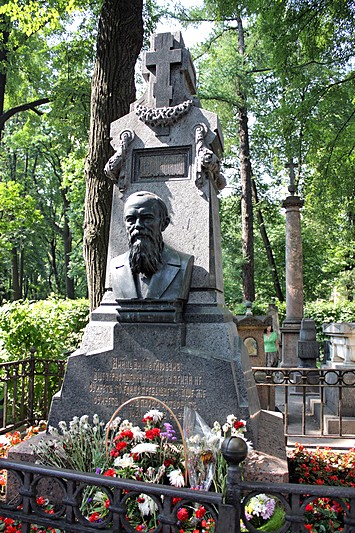Cemetery and Tombs of the Alexander Nevsky Monastery
This is perhaps the most famous and most visited cemetery in St. Petersburg. In a relatively small area around the Alexander Nevsky Monastery are four historic cemeteries - Lazarevskoe, Tikhvinskoe, Nikolskoe, and Kazache (Cossack), as well as the Church of the Annunciation - the first stone temple and mausoleum of St. Petersburg and the first resting place for the tsarist family. Today, all the cemeteries of the Alexander Nevsky Monastery are part of the State Museum of Urban Sculpture. In the 20th century, the graves of many prominent St. Petersburg residents that were deteriorating in dilapidated cemeteries were moved here. The monastery contains the graves of the writer Fyodor Dostoyevsky, famous composers Pyotr Tchaikovsky, Modest Mussorgsky, and Nikolay Rimsky-Korsakov, and numerous other luminaries.

The first burials in the Alexander Nevsky Monastery date back to the 1720s. They were carried out at two churches (burial vaults): the Church of the Annunciation and the Church of St. Lazarus. Marble tombstones for relatives of Peter I are preserved here, including those of Tsaritsa Praskovia Fyodorovna, wife of Ivan V, and Peter's granddaughter Grand Duchess Natalia Alekseevna, etc. In the second half of the 18th century sculpted tombstones began to appear; however, the most remarkable grave of this era was the modest slab of white marble under which Generalissimo Alexander Suvorov was buried in 1800.

One of the oldest cemeteries in St. Petersburg appeared almost immediately next to the Church of St. Lazarus after its completion: the Lazarevskoe. Mainly prominent people were buried here, and there are many different tombstones, sarcophagi, columns, stelae, and obelisks. All are striking in their artistic appearance and allegorical symbolism. Today the cemetery is called the Necropolis of the 18th Century and well known graves include the great Swiss-born mathematician and physicist Leonhard Euler; architects Andrey Voronikhin, Giacomo Quarenghi, Thomas de Tomona, and Carlo Rossi; Pushkin's widow Nathalie Pushkina-Lanskaya; and many others. More than 1 000 gravestones from the 18th - 20th centuries can be found here.

In 1823, the Tikhvinskoe Cemetery was founded next to the already crowded Lazarevskoe cemetery. During the 19th century a large number of famous scientists and artists were buried here, among them the historian Nikolay Karamzin; poets Vasily Zhukovsky and Nikolay Gnedich; writers Fyodor Dostoevsky and Ivan Krylov; composers Modest Mussorgsky, Alexander Borodin, and Pyotr Tchaikovsky; artists Ivan Kramskoy, Arkhip Kuindzhi ,and Boris Kustodiev; and explorer Yury Lisyansky. The monuments dedicated to these people are outstanding pieces of art in their own right and were created by the best sculptors of the time: Nicholay Lancer, Peter von Klodt, Nikolay Roerich, Alexei Shchusev, and others. Currently, the Tikhvinskoe Cemetery is known as the Necropolis of Artists.
The next cemetery founded in the Alexander Nevsky Monastery was the Nikolskoe in 1863. One can find many chapels used for burials decorated in the Ancient Russian style here as well as modernist style tombstones decorated with mosaics and majolica. In the 20th century, several well-known individuals were buried here: the first Russian aviators Sergei Utochkin and Leo Matsievich; historian Lev Gumilev; and former mayor of St. Petersburg Anatoly Sobchak. Finally in 1917, a small cemetery in the courtyard of the monastery - where Cossacks, Bolshevik demonstration participants, and heroes of the Civil War were buried - was re-named the Communist Cemetery. Today, this small cemetery has regained its historic name - Kazachoe (Cossack).
In 1939, the Museum of Urban Sculpture was founded on part of the monastery's territory. This museum is engaged in the conservation of city memorials and statues, as well as organizing exhibitions of sculpture. All of the cemeteries and tombs of the Lavra were restored, and a large number of artistic monuments from other cemeteries and churches were moved here. Today the complex of cemeteries at the Alexander Nevsky Lavra can certainly be called a unique memorial museum and one that helps give an understanding of three centuries of both Russia's and St. Petersburg's history.
| Address: | 179, Nevsky Prospekt |
|---|---|
| Metro stations: | Ploshchad Alexandra Nevskogo |
| Directions: | Exiting the Ploshchad Alexandra Nevskogo Metro Station from either exit will bring you onto Ploshchad Alexandra Nevskogo, opposite the main gates of the monastery |
| Opening hours: | http://www.gmgs.ru/contacts/worktime |
| Tickets: | http://www.gmgs.ru/contacts/price |
| What's nearby? | Alexander Nevsky Lavra, Ploshchad Alexandra Nevskogo, Alexander Nevsky Bridge, Neva River, Obvodny Canal, Moscow Hotel |







